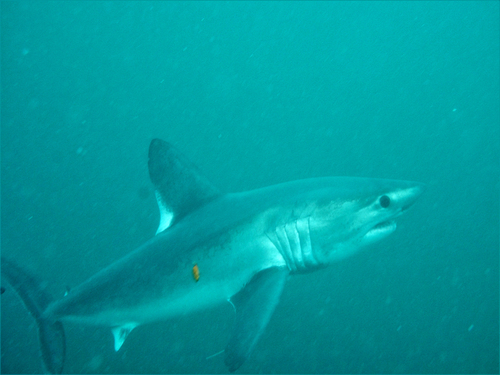
Porbeagle
The Atlantic bluefin tuna (Thunnus thynnus) is a majestic and highly migratory species of tuna renowned for its size, speed, and commercial value. As one of the largest bony fish, it plays a crucial role in the marine ecosystem. This species is a top predator, capable of impressive feats of endurance and speed.
30 65 years
Lifespan
370 cm
Length
Vulnerable
Conservation Status
74 km/h
Swimming speed
Carnivorous
Diet
Highly Migratory, Seasonal Migration
Migration
Appearance Overview
The Atlantic bluefin tuna is a large, streamlined fish with a metallic blue body and a silvery underside.
Coloration
Dark metallic blue on top, silvery underside
Body Shape
Torpedo-shaped, built for speed and endurance
Fins
Two dorsal fins, the first depressible; small finlets running from dorsal and anal fins to tail
Tail
Crescent-shaped, powerful for propulsion
Length
Up to 13 feet (4 meters), commonly around 6.5 feet (2 meters)
Weight
Up to 2,000 lbs (907 kg), commonly around 550 lbs (250 kg)
Diet
Carnivorous, feeding on a variety of fish (such as herring, mackerel, and bluefish), squid, crustaceans, and eels.
Feeding Behavior
Highly active predator, using speed and agility to hunt. They are opportunistic feeders and can hunt individually or cooperatively, sometimes herding prey.
Social Behavior
Forms large schools, especially during migration. Schools may be segregated by size. They are highly migratory, capable of crossing the Atlantic Ocean.
Commercial Relevance
Extremely high value, especially in the sushi and sashimi markets, where a single fish can fetch tens or even hundreds of thousands of dollars.
Conservation measures
Subject to international fishing quotas and regulations managed by organizations like ICCAT. Efforts include minimum size limits, seasonal closures, and monitoring programs.
Status
Endangered (IUCN)
Threats
Overfishing (historically and ongoing), bycatch in fisheries targeting other species, habitat degradation (particularly spawning grounds), and climate change affecting prey distribution.
Habitat Distribution
Depth Range
Surface waters to depths of over 3,000 feet (1,000 meters), but typically found in the upper few hundred feet.
Geographic Range
Western and eastern Atlantic Ocean, Mediterranean Sea. Historically also in the Black Sea.
Preferred Environment
Pelagic, open ocean environments, ranging from temperate to subtropical waters. They prefer areas with specific temperature ranges for spawning.
Reproduction and Life Cycle
Breeding Habits
Spawns in two main areas: the Mediterranean Sea and the Gulf of Mexico. Spawning occurs in warm waters, typically from May to July in the Mediterranean and April to June in the Gulf of Mexico.
Development Stages
Eggs are pelagic (free-floating). Larvae develop rapidly, feeding on plankton. Juveniles grow quickly, forming schools and gradually transitioning to a diet of fish and invertebrates.
Fecundity
Highly fecund; a single female can release up to 30 million eggs per spawning season.
Maturity Age
Matures at around 4-8 years in the western Atlantic and slightly earlier (3-5 years) in the eastern Atlantic and Mediterranean.
Faqs about Porbeagle
Where are Atlantic bluefin tuna found?
Atlantic bluefin tuna are found in the western and eastern Atlantic Ocean, as well as the Mediterranean Sea.
How long do Atlantic bluefin tuna live?
They can live up to 40 years, although this is becoming rarer due to fishing pressure.
Are Atlantic bluefin tuna warm-blooded?
Yes, they are warm-blooded, unlike most fish. They have a specialized circulatory system that helps them maintain a body temperature higher than the surrounding water.
How fast can Atlantic bluefin tuna swim?
Atlantic bluefin tuna are among the fastest fish, capable of bursts of speed up to 43 mph (70 km/h).
Do Atlantic bluefin tuna migrate?
Yes, they are highly migratory and can travel thousands of miles across oceans.
Do Atlantic Bluefin Tuna have any predators?
They are an apex predator, meaning they are at the top of the food chain. While young tuna may be preyed upon by larger fish and sharks, adults have few natural predators other than large sharks and orcas.
Copyright @ Nature Style Limited. All Rights Reserved.
 English
English